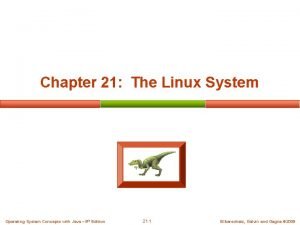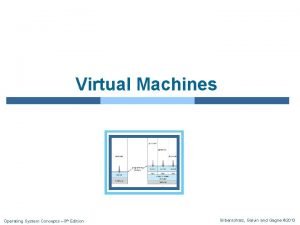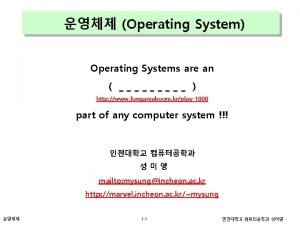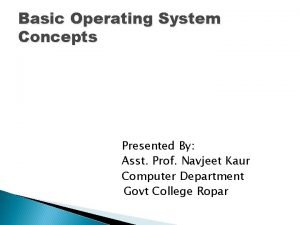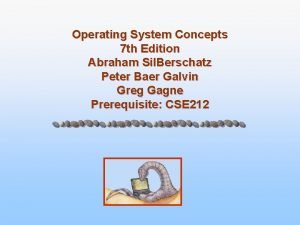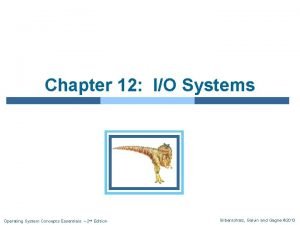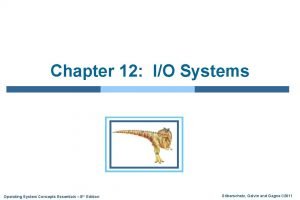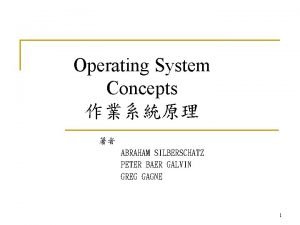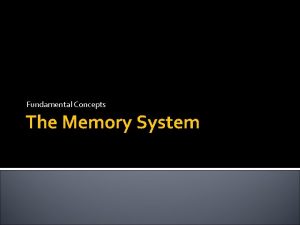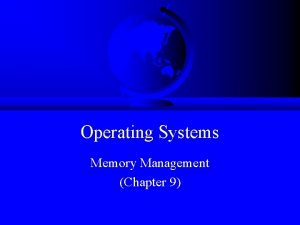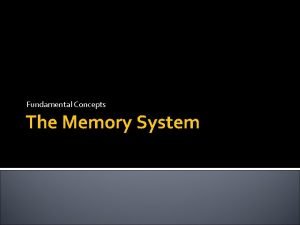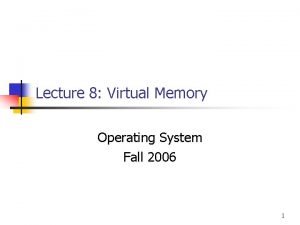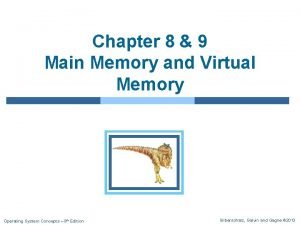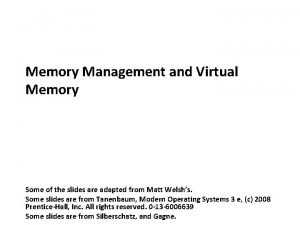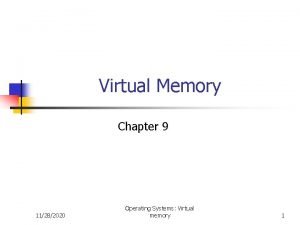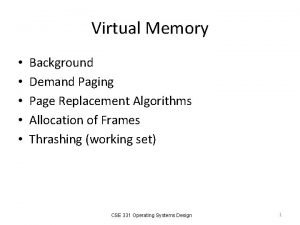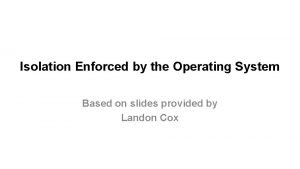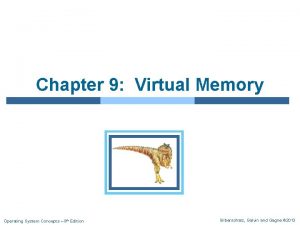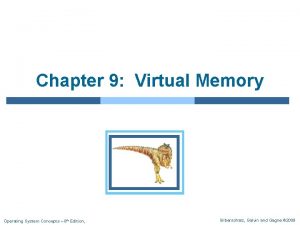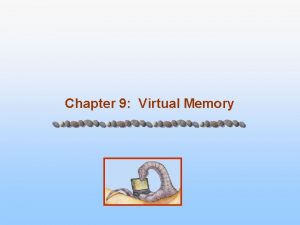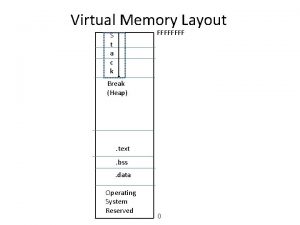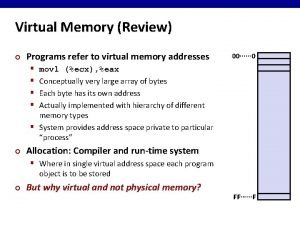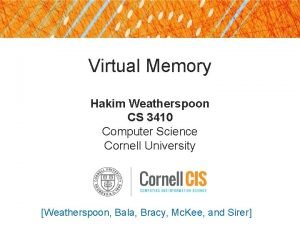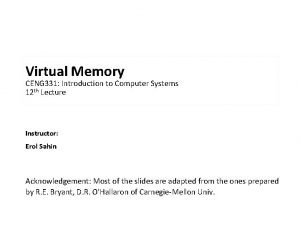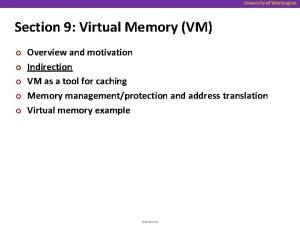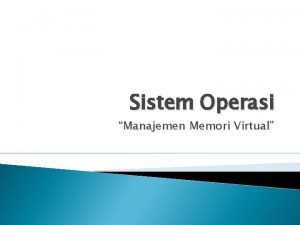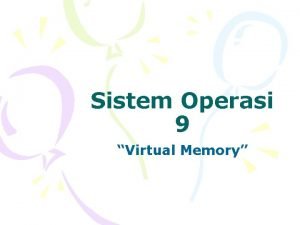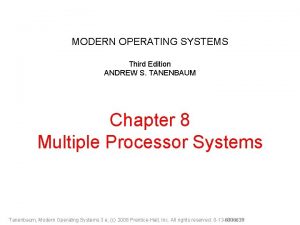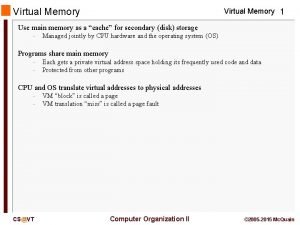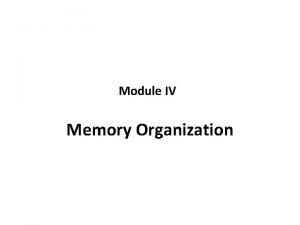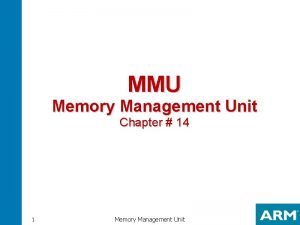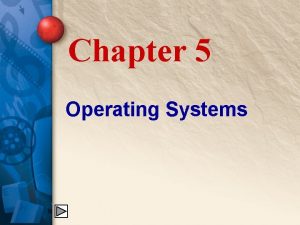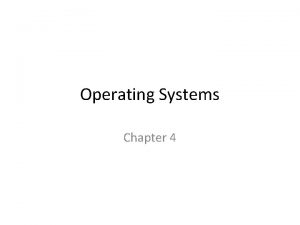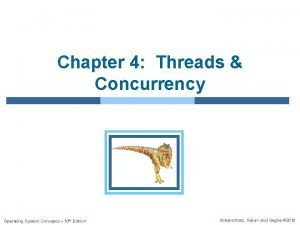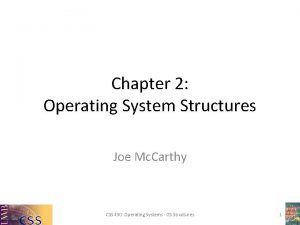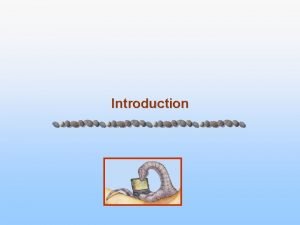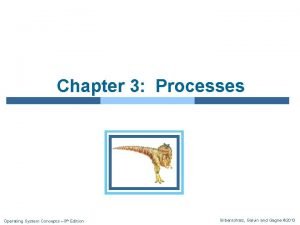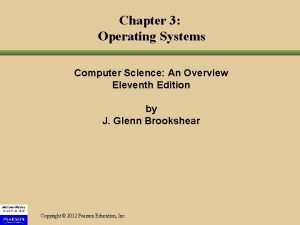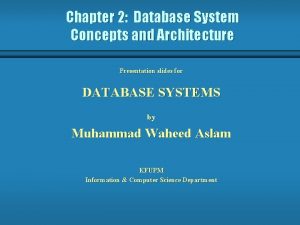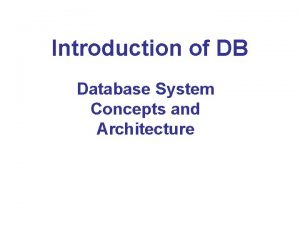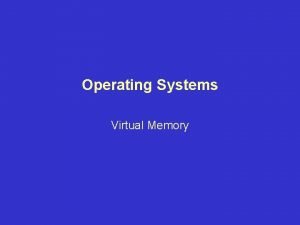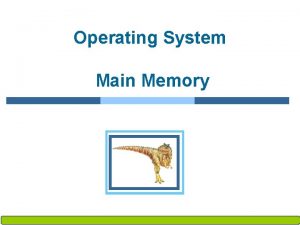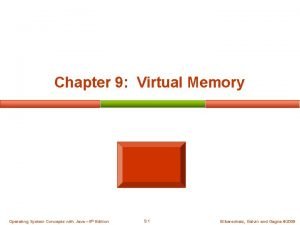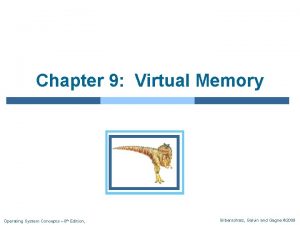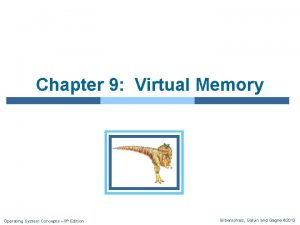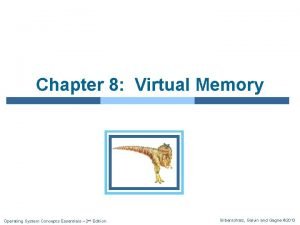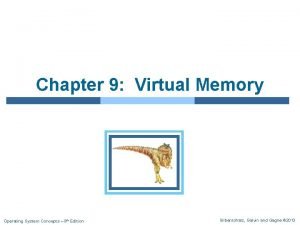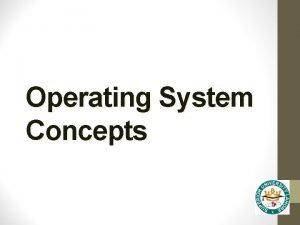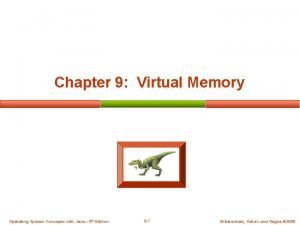Chapter 9 Virtual Memory Operating System Concepts 8



























































































- Slides: 91

Chapter 9: Virtual Memory Operating System Concepts– 8 th Edition Silberschatz, Galvin and Gagne © 2009

Chapter 9: Virtual Memory n Background n Demand Paging n Copy-on-Write n Page Replacement n Allocation of Frames n Thrashing n Memory-Mapped Files n Allocating Kernel Memory n Other Considerations n Operating-System Examples Operating System Concepts– 8 th Edition 9. 2 Silberschatz, Galvin and Gagne © 20009

Objectives n To describe the benefits of a virtual memory system n To explain the concepts of demand paging, page-replacement algorithms, and allocation of page frames n To discuss the principle of the working-set model Operating System Concepts– 8 th Edition 9. 3 Silberschatz, Galvin and Gagne © 20009

BACKGROUND Operating System Concepts– 8 th Edition 9. 4 Silberschatz, Galvin and Gagne © 20009

Background n Code needs to be in memory to execute, but entire program rarely used l Error code, unusual routines, large data structures n Entire program code not needed at same time n Consider ability to execute partially-loaded program l Program no longer constrained by limits of physical memory Operating System Concepts– 8 th Edition 9. 5 Silberschatz, Galvin and Gagne © 20009

Background n Virtual memory – separation of user logical memory from physical memory l Only part of the program needs to be in memory for execution 4 More programs running concurrently 4 Less I/O needed to load or swap processes l Logical address space can be much larger than physical address space l Allows address spaces to be shared by several processes l Allows for more efficient process creation n Virtual memory can be implemented via: l Demand paging l Demand segmentation Operating System Concepts– 8 th Edition 9. 6 Silberschatz, Galvin and Gagne © 20009

Virtual Memory That is Larger Than Physical Memory Image Source: Wikipedia Operating System Concepts– 8 th Edition 9. 7 Silberschatz, Galvin and Gagne © 20009

Virtual Address Space n Enables sparse address spaces with holes left for growth, dynamically linked libraries, etc n System libraries shared via mapping into virtual address space n Shared memory by mapping pages read-write into virtual address space n Pages can be shared during fork(), speeding process creation Operating System Concepts– 8 th Edition 9. 8 Silberschatz, Galvin and Gagne © 20009

Shared Library Using Virtual Memory Operating System Concepts– 8 th Edition 9. 9 Silberschatz, Galvin and Gagne © 20009

DEMAND PAGING Operating System Concepts– 8 th Edition 9. 10 Silberschatz, Galvin and Gagne © 20009

Demand Paging n Could bring entire process into memory at load time n Or bring a page into memory only when it is needed Less I/O needed, no unnecessary I/O l Less memory needed l Faster response l More users l n Page is needed: invalid reference abort 2. not-in-memory bring to memory n Lazy swapper – never swaps a page into memory unless page will be needed l Swapper that deals with pages is a pager 1. Operating System Concepts– 8 th Edition 9. 11 Silberschatz, Galvin and Gagne © 20009

Transfer of a Paged Memory to Contiguous Disk Space Operating System Concepts– 8 th Edition 9. 12 Silberschatz, Galvin and Gagne © 20009

Valid-Invalid Bit n With each page table entry a valid–invalid bit is associated (v in-memory – memory resident, i not-in-memory) n Initially valid–invalid bit is set to i on all entries n Example of a page table Framesnapshot: # valid-invalid bit v v i …. i i page table n During address translation, if valid–invalid bit in page table entry is i page fault Operating System Concepts– 8 th Edition 9. 13 Silberschatz, Galvin and Gagne © 20009

Page Table When Some Pages Are Not in Main Memory Operating System Concepts– 8 th Edition 9. 14 Silberschatz, Galvin and Gagne © 20009

Page Fault 1. If there is a reference to a page, first reference to that page will trap to operating system, causing a page fault 2. Operating system looks at another table to decide: l Invalid reference abort l Just not in memory 3. Find empty frame 4. Swap page into frame via scheduled disk operation 5. Reset tables to indicate page now in memory Set validation bit = v 6. Restart the instruction that caused the page fault Operating System Concepts– 8 th Edition 9. 15 Silberschatz, Galvin and Gagne © 20009

Steps in Handling a Page Fault Operating System Concepts– 8 th Edition 9. 16 Silberschatz, Galvin and Gagne © 20009

Aspects of Demand Paging n Extreme case – start process with no pages in memory (Pure demand paging) l OS sets instruction pointer to first instruction of process, non-memoryresident -> page fault l And for every other process pages on first access n Actually, a given instruction could access multiple pages -> multiple page faults l Pain decreased because of locality of reference n Hardware support needed for demand paging l Page table with valid-invalid bit l Secondary memory (swap device with swap space) l Instruction restart Operating System Concepts– 8 th Edition 9. 17 Silberschatz, Galvin and Gagne © 20009

Instruction Restart n Consider an instruction that could access several different locations l Block move Increment/decrement location l Restart the whole operation? 4 What if source and destination overlap? l Operating System Concepts– 8 th Edition 9. 18 Silberschatz, Galvin and Gagne © 20009

Performance of Demand Paging n Stages in Demand Paging 1. Trap to the operating system 2. Save the user registers and process state 3. Determine that the interrupt was a page fault 4. Check that the page reference was legal and determine the location of the page on the disk 5. Issue a read from the disk to a free frame: 1. Wait in a queue for this device until the read request is serviced 2. Wait for the device seek and/or latency time 3. Begin the transfer of the page to a free frame Operating System Concepts– 8 th Edition 9. 19 Silberschatz, Galvin and Gagne © 20009

Performance of Demand Paging (Cont. ) n Stages in Demand Paging (Cont. ) 6. While waiting, allocate the CPU to some other process 7. Receive an interrupt from the disk I/O subsystem (I/O completed) 8. Save the registers and process state for the other process 9. Determine that the interrupt was from the disk 10. Correct the page table and other tables to show page is now in memory 11. Wait for the CPU to be allocated to this process again 12. Restore the user registers, process state, and new page table, and then resume the interrupted instruction Operating System Concepts– 8 th Edition 9. 20 Silberschatz, Galvin and Gagne © 20009

Performance of Demand Paging (Cont. ) n Page Fault Rate 0 p 1 l If p = 0 no page faults l If p = 1, every reference is a fault n Effective Access Time (EAT) EAT = (1 – p) x memory access + p (page fault overhead + swap page out + swap page in + restart overhead ) Operating System Concepts– 8 th Edition 9. 21 Silberschatz, Galvin and Gagne © 20009

Demand Paging Example n Memory access time = 200 nanoseconds n Average page-fault service time = 8 milliseconds n EAT = (1 – p) x 200 + p (8 milliseconds) = (1 – p) x 200 + p x 8, 000 = 200 + p x 7, 999, 800 n If one access out of 1, 000 causes a page fault, then EAT = 8. 2 microseconds. This is a slowdown by a factor of 40!! n If want performance degradation < 10 percent l 220 > 200 + 7, 999, 800 x p 20 > 7, 999, 800 x p l p <. 0000025 l < one page fault in every 400, 000 memory accesses Operating System Concepts– 8 th Edition 9. 22 Silberschatz, Galvin and Gagne © 20009

Demand Paging Optimizations n Copy entire process image to swap space at process load time l Then page in and out of swap space l Used in older BSD Unix n Demand page in from program binary on disk, but discard rather than paging out when freeing frame (because they were never modified) l Used in Solaris and current BSD Operating System Concepts– 8 th Edition 9. 23 Silberschatz, Galvin and Gagne © 20009

COPY-ON-WRITE Operating System Concepts– 8 th Edition 9. 24 Silberschatz, Galvin and Gagne © 20009

Copy-on-Write n Copy-on-Write (COW) allows both parent and child processes to initially share the same pages in memory l If either process modifies a shared page, only then is the page copied n COW allows more efficient process creation as only modified pages are copied n In general, free pages are allocated from a pool of zero-fill-on-demand pages l Why zero-out a page before allocating it? n vfork() variation on fork() system call has parent suspend and child using copy-on-write address space of parent l Designed to have child call exec() l Very efficient Operating System Concepts– 8 th Edition 9. 25 Silberschatz, Galvin and Gagne © 20009

Copy-On-Write Example Before process 1 modifies page C: Operating System Concepts– 8 th Edition 9. 26 Silberschatz, Galvin and Gagne © 20009

Copy-On-Write Example After process 1 modifies page C: Operating System Concepts– 8 th Edition 9. 27 Silberschatz, Galvin and Gagne © 20009

PAGE REPLACEMENT Operating System Concepts– 8 th Edition 9. 28 Silberschatz, Galvin and Gagne © 20009

What Happens if There is no Free Frame? n All frames allocated to: l Process pages l Kernel l I/O buffers l Etc. n How much to allocate to each? n Page-replacement – find some page in memory (hopefully not in use) and page it out l Algorithm – terminate? swap out? replace the page? l Performance – want an algorithm which will result in minimum number of page faults n Same page may be brought into memory several times Operating System Concepts– 8 th Edition 9. 29 Silberschatz, Galvin and Gagne © 20009

Page Replacement n Prevent over-allocation of memory by modifying page-fault service routine to include page replacement n Use modify (dirty) bit to reduce overhead of page transfers – only modified pages are written to disk n Page replacement completes separation between logical memory and physical memory – large virtual memory can be provided on a smaller physical memory Operating System Concepts– 8 th Edition 9. 30 Silberschatz, Galvin and Gagne © 20009

Need For Page Replacement Operating System Concepts– 8 th Edition 9. 31 Silberschatz, Galvin and Gagne © 20009

Basic Page Replacement 1. Find the location of the desired page on disk 2. Find a free frame: a. If there is a free frame, use it b. If there is no free frame, use a page replacement algorithm to select a victim frame c. Write victim frame to disk if dirty 3. Bring the desired page into the (newly) free frame; update the page and frame tables 4. Continue the process by restarting the instruction that caused the trap Note now potentially 2 page transfers per page fault, increasing EAT Operating System Concepts– 8 th Edition 9. 32 Silberschatz, Galvin and Gagne © 20009

Page Replacement Operating System Concepts– 8 th Edition 9. 33 Silberschatz, Galvin and Gagne © 20009

Page and Frame Replacement Algorithms n Frame-allocation algorithm determines l How many frames to give each process l Which frames to replace n Page-replacement algorithm l Want lowest page-fault rate on both first access and re-access n Evaluate algorithm by running it on a particular string of memory references (reference string) and computing the number of page faults on that string l String is just page numbers, not full addresses l Repeated access to the same page does not cause a page fault n In all our examples, the reference string is 7, 0, 1, 2, 0, 3, 0, 4, 2, 3, 0, 3, 2, 1, 2, 0, 1, 7, 0, 1 Operating System Concepts– 8 th Edition 9. 34 Silberschatz, Galvin and Gagne © 20009

Graph of Page Faults Versus The Number of Frames Operating System Concepts– 8 th Edition 9. 35 Silberschatz, Galvin and Gagne © 20009

First-In-First-Out (FIFO) Algorithm 15 page faults n How to track ages of pages? l Just use a FIFO queue Operating System Concepts– 8 th Edition 9. 36 Silberschatz, Galvin and Gagne © 20009

FIFO Page Replacement Exercise n Diagram which page is in which frame for the following reference string: 1, 2, 3, 4, 1, 2, 5, 1, 2, 3, 4, 5. Also count number of page faults. l 3 frames l 4 frames Operating System Concepts– 8 th Edition 9. 37 Silberschatz, Galvin and Gagne © 20009

FIFO Page Replacement Exercise n Diagram which page is in which frame for the following reference string: 1, 2, 3, 4, 1, 2, 5, 1, 2, 3, 4, 5. Also count number of page faults. l 3 frames 4 1, 2, 3, 4, 1, 2, 5, 1, 2, 3, 4, 5 49 l page faults 4 frames 4 1, 2, 3, 4, 1, 2, 5, 1, 2, 3, 4, 5 4 10 l page faults! Adding more frames can cause more page faults! (Belady’s Anomaly) Operating System Concepts– 8 th Edition 9. 38 Silberschatz, Galvin and Gagne © 20009

FIFO Illustrating Belady’s Anomaly Operating System Concepts– 8 th Edition 9. 39 Silberschatz, Galvin and Gagne © 20009

Optimal Algorithm n Replace page that will not be used for longest period of time n How do you know this? l Can’t read the future n Used for measuring how well your algorithm performs Operating System Concepts– 8 th Edition 9. 40 Silberschatz, Galvin and Gagne © 20009

Optimal Page Replacement 9 page faults Operating System Concepts– 8 th Edition 9. 41 Silberschatz, Galvin and Gagne © 20009

Least Recently Used (LRU) Algorithm n Use past knowledge rather than future n Replace page that has not been used in the most amount of time n Associate time of last use with each page n 12 page faults – better than FIFO but worse than OPT n Generally good algorithm and frequently used n But how to implement? Operating System Concepts– 8 th Edition 9. 42 Silberschatz, Galvin and Gagne © 20009

LRU Algorithm (Cont. ) ① Counter implementation l Every page entry has a counter; every time page is referenced through this entry, copy the clock into the counter l When replacing a page, find smallest counter value 4 Need to search through page table ② Stack implementation l Keep a stack of page numbers in a doubly linked list: l Page referenced, move it to the top 4 Requires l 6 pointers to be changed Each update more expensive, but no search for replacement n LRU and OPT are cases of stack algorithms that don’t have Belady’s Anomaly Operating System Concepts– 8 th Edition 9. 43 Silberschatz, Galvin and Gagne © 20009

Use Of A Stack to Record The Most Recent Page References Operating System Concepts– 8 th Edition 9. 44 Silberschatz, Galvin and Gagne © 20009

LRU Approximation Algorithms n LRU needs special hardware and still slow n Reference bit l Associate a bit with each page, initially = 0 l When page is referenced bit set to 1 l Replace a page with reference bit = 0 (if one exists) 4 We do not know the order, however n Second-chance algorithm (“clock algorithm”) l Generally FIFO, plus hardware-provided reference bit l If page to be replaced has 4 Reference bit = 0 -> replace it 4 Reference bit = 1 then: – Set reference bit 0, leave page in memory – Replace next page, subject to same rules Operating System Concepts– 8 th Edition 9. 45 Silberschatz, Galvin and Gagne © 20009

Second-Chance (clock) Page-Replacement Algorithm Operating System Concepts– 8 th Edition 9. 46 Silberschatz, Galvin and Gagne © 20009

Counting Algorithms n Keep a counter of the number of references that have been made to each page l Not common n LFU Algorithm (Least Frequently Used) l Replace page with smallest count n MFU Algorithm (Most Frequently Used) l Based on the argument that the page with the smallest count was probably just brought in and has yet to be used Operating System Concepts– 8 th Edition 9. 47 Silberschatz, Galvin and Gagne © 20009

Page-Buffering Algorithms n Keep a pool of free frames, always l When a frames is needed, immediately use frame from pool (if available) and select victim to evict and add to free pool l When convenient, evictim l (Frame is available when needed, not found at fault time) n Possibly, keep list of modified pages l When backing store otherwise idle, write pages there and set to nondirty n Possibly, keep free frame contents intact and note their physical address l If referenced again before reused, no need to load contents again from disk l Generally useful to reduce penalty if wrong victim frame selected Operating System Concepts– 8 th Edition 9. 48 Silberschatz, Galvin and Gagne © 20009

Applications and Page Replacement n All of these algorithms have OS guessing about future page access n Some applications have better knowledge – i. e. databases n Memory intensive applications can cause double buffering l OS keeps copy of page in memory as I/O buffer l Application keeps page in memory for its own work n Operating system can given direct access to the disk, getting out of the way of the applications l Raw disk mode n Bypasses buffering, locking, etc Operating System Concepts– 8 th Edition 9. 49 Silberschatz, Galvin and Gagne © 20009

ALLOCATION OF FRAMES Operating System Concepts– 8 th Edition 9. 50 Silberschatz, Galvin and Gagne © 20009

Allocation of Frames n Each process needs a minimum number of frames n Example: IBM 370 – 6 pages to handle SS MOVE instruction: l instruction is 6 bytes, might span 2 pages l 2 pages to handle from l 2 pages to handle to n Maximum of course is total frames in the system n Two major allocation schemes l fixed allocation l priority allocation n Many variations Operating System Concepts– 8 th Edition 9. 51 Silberschatz, Galvin and Gagne © 20009

Fixed Allocation n Equal allocation – For example, if there are 100 frames (after allocating frames for the OS) and 5 processes, give each process 20 frames l Keep some as free frame buffer pool n Proportional allocation – Allocate according to the size of process l Dynamic as degree of multiprogramming, process sizes change Operating System Concepts– 8 th Edition 9. 52 Silberschatz, Galvin and Gagne © 20009

Priority Allocation n Use a proportional allocation scheme using priorities rather than size n If process Pi generates a page fault, a. Select for replacement one of its frames b. Select for replacement a frame from a process with lower priority number Operating System Concepts– 8 th Edition 9. 53 Silberschatz, Galvin and Gagne © 20009

Global vs. Local Allocation n Global replacement – process selects a replacement frame from the set of all frames; one process can take a frame from another l But then process execution time can vary greatly l But greater throughput so more common n Local replacement – each process selects from only its own set of allocated frames l More consistent per-process performance l But possibly underutilized memory Operating System Concepts– 8 th Edition 9. 54 Silberschatz, Galvin and Gagne © 20009

Non-Uniform Memory Access n So far we assumed that all memory is accessed equally n Many systems are NUMA – speed of access to memory varies l Consider system boards containing CPUs and memory, interconnected over a system bus n Optimal performance comes from allocating memory “close to” the CPU on which the thread is scheduled l And modifying the scheduler to schedule thread on the same system board when possible l Solved by Solaris by creating lgroups 4 Structure 4 Used to track CPU / Memory low latency groups by schedule and pager 4 When possible schedule all threads of a process and allocate all memory for that process within the lgroup Operating System Concepts– 8 th Edition 9. 55 Silberschatz, Galvin and Gagne © 20009

THRASHING Operating System Concepts– 8 th Edition 9. 56 Silberschatz, Galvin and Gagne © 20009

Thrashing n If a process does not have “enough” pages, the page-fault rate is very high l Page fault to get page l Replace existing frame l But quickly need replaced frame back l This leads to: 4 Low CPU utilization 4 Operating system thinking that it needs to increase the degree of multiprogramming 4 Another process added to the system n Thrashing: a process is busy swapping pages in and out Operating System Concepts– 8 th Edition 9. 57 Silberschatz, Galvin and Gagne © 20009

Thrashing (Cont. ) Operating System Concepts– 8 th Edition 9. 58 Silberschatz, Galvin and Gagne © 20009

Demand Paging and Thrashing n Why does demand paging work? Locality model l Process migrates from one locality to another l Localities may overlap n Why does thrashing occur? size of locality > total memory size l Limit effects by using local or priority page replacement Operating System Concepts– 8 th Edition 9. 59 Silberschatz, Galvin and Gagne © 20009

Locality In A Memory-Reference Pattern Operating System Concepts– 8 th Edition 9. 60 Silberschatz, Galvin and Gagne © 20009

Working-Set Model n = working-set window = a fixed number of page references Example: 10, 000 instructions n WSSi (working set size of process Pi) = total number of pages referenced in the most recent (varies in time) l If too small will not encompass entire locality l If too large will encompass several localities l If = will encompass entire program n D = WSSi total demand frames l Approximation of locality n If D > m Thrashing n Policy if D > m, then suspend or swap out one of the processes Operating System Concepts– 8 th Edition 9. 61 Silberschatz, Galvin and Gagne © 20009

Working-Set Model Operating System Concepts– 8 th Edition 9. 62 Silberschatz, Galvin and Gagne © 20009

Keeping Track of the Working Set n Approximate with interval timer + a reference bit n Example: = 10, 000 l Timer interrupts after every 5000 time units l Keep in memory 2 bits for each page l Whenever a timer interrupts copy and clear the reference bits l If one of the bits in memory = 1 page in working set n Why is this not completely accurate? n Improvement: 10 bits and interrupt every 1000 time units Operating System Concepts– 8 th Edition 9. 63 Silberschatz, Galvin and Gagne © 20009

Page-Fault Frequency n More direct approach than WSS n Establish “acceptable” page-fault frequency rate and use local replacement policy l If actual rate too low, process loses frame l If actual rate too high, process gains frame Operating System Concepts– 8 th Edition 9. 64 Silberschatz, Galvin and Gagne © 20009

Working Sets and Page Fault Rates Operating System Concepts– 8 th Edition 9. 65 Silberschatz, Galvin and Gagne © 20009

MEMORY-MAPPED FILES Operating System Concepts– 8 th Edition 9. 66 Silberschatz, Galvin and Gagne © 20009

Memory-Mapped Files n Memory-mapped file I/O allows file I/O to be treated as routine memory access by mapping a disk block to a page in memory n A file is initially read using demand paging l A page-sized portion of the file is read from the file system into a physical page l Subsequent reads/writes to/from the file are treated as ordinary memory accesses n Simplifies and speeds file access by driving file I/O through memory rather than read() and write() system calls n Also allows several processes to map the same file allowing the pages in memory to be shared n But when does written data make it to disk? l Periodically and / or when close() is called l For example, when the pager scans for dirty pages Operating System Concepts– 8 th Edition 9. 67 Silberschatz, Galvin and Gagne © 20009

Memory-Mapped File Technique for all I/O n Some OSs use memory mapped files for standard I/O n Processes can explicitly request memory mapping a file via mmap() system call l Now file mapped into process address space n For standard I/O (open(), read(), write()), mmap anyway l But map file into kernel address space l Process still does read() and write() 4 Copies l data to and from kernel space and user space Uses efficient memory management subsystem 4 Avoids needing separate subsystem n Copy-On-Write can be used for read/write non-shared pages n Memory mapped files can be used for shared memory Operating System Concepts– 8 th Edition 9. 68 Silberschatz, Galvin and Gagne © 20009

Memory Mapped Files Operating System Concepts– 8 th Edition 9. 69 Silberschatz, Galvin and Gagne © 20009

Memory-Mapped Shared Memory in Windows Operating System Concepts– 8 th Edition 9. 70 Silberschatz, Galvin and Gagne © 20009

ALLOCATING KERNEL MEMORY Operating System Concepts– 8 th Edition 9. 71 Silberschatz, Galvin and Gagne © 20009

Allocating Kernel Memory n Treated differently from user memory n Often allocated from a free-memory pool l Kernel requests memory for structures of varying sizes l Some kernel memory needs to be contiguous 4 I. e. for device I/O Operating System Concepts– 8 th Edition 9. 72 Silberschatz, Galvin and Gagne © 20009

Buddy System n Allocates memory from fixed-size segment consisting of physically- contiguous pages n Memory allocated using power-of-2 allocator l Satisfies requests in units sized as power of 2 l Request rounded up to next highest power of 2 l When smaller allocation needed than is available, current chunk split into two buddies of next-lower power of 2 4 Continue until appropriate sized chunk available n For example, assume 256 KB chunk available, kernel requests 21 KB l Split into AL and Ar of 128 KB each, then split AL into BL and BR (each 64 KB) and then split BL into CL and CR (each 32 KB). Use CL. n Advantage – quickly coalesce unused chunks into larger chunk n Disadvantage – internal fragmentation Operating System Concepts– 8 th Edition 9. 73 Silberschatz, Galvin and Gagne © 20009

Buddy System Allocator Operating System Concepts– 8 th Edition 9. 74 Silberschatz, Galvin and Gagne © 20009

Slab Allocator n Alternate strategy n Slab is one or more physically contiguous pages n Cache consists of one or more slabs n Single cache for each unique kernel data structure l Each cache filled with objects – instantiations of the data structure n When cache created, filled with objects marked as free n When structures stored, objects marked as used n If slab is full of used objects, next object allocated from empty slab l If no empty slabs, new slab allocated n Benefits include no fragmentation, fast memory request satisfaction Operating System Concepts– 8 th Edition 9. 75 Silberschatz, Galvin and Gagne © 20009

Slab Allocation Operating System Concepts– 8 th Edition 9. 76 Silberschatz, Galvin and Gagne © 20009

OTHER CONSIDERATIONS Operating System Concepts– 8 th Edition 9. 77 Silberschatz, Galvin and Gagne © 20009

Other Issues – Prepaging n To reduce the large number of page faults that occurs at process startup n Prepage all or some of the pages a process will need, before they are referenced n But if prepaged pages are unused, I/O and memory wasted n Assume s pages are prepaged and α of the pages are used l Is cost of s * α save pages faults > or < than the cost of prepaging s * (1 - α) unnecessary pages? l α near zero prepaging loses Operating System Concepts– 8 th Edition 9. 78 Silberschatz, Galvin and Gagne © 20009

Other Issues – Page Size n Sometimes OS designers have a choice (e. g. custom-built CPU) n Page size selection must take into consideration: l Fragmentation l Page table size l Resolution l I/O overhead l Number of page faults l Locality l TLB size and effectiveness n Always power of 2, usually in the range 212 (4, 096 bytes) to 222 (4, 194, 304 bytes) n On average, growing over time Operating System Concepts– 8 th Edition 9. 79 Silberschatz, Galvin and Gagne © 20009

Other Issues – TLB Reach n TLB Reach - The amount of memory accessible from the TLB n TLB Reach = (TLB Size) X (Page Size) n Ideally, the working set of each process is stored in the TLB l Otherwise low hit ratio (requiring use of slower page table) n Increase the Page Size l This may lead to an increase in fragmentation as not all applications require a large page size n Provide Multiple Page Sizes l This allows applications that require larger page sizes the opportunity to use them without an increase in fragmentation Operating System Concepts– 8 th Edition 9. 80 Silberschatz, Galvin and Gagne © 20009

Other Issues – Program Structure n Assume page size = 128 words n data is a 128 x 128 int array (each row is stored in one page) n Program 1 for(j = 0; j < 128; j++) for(i = 0; i < 128; i++) data[i, j] = 0; 128 x 128 = 16, 384 page faults n Program 2 for(i = 0; i < 128; i++) for(j = 0; j < 128; j++) data[i, j] = 0; 128 page faults Operating System Concepts– 8 th Edition 9. 81 Silberschatz, Galvin and Gagne © 20009

Other Issues – I/O interlock n I/O Interlock – Pages must sometimes be locked into memory n Consider I/O - Pages that are used for copying a file from a device must be locked from being selected for eviction by a page replacement algorithm Operating System Concepts– 8 th Edition 9. 82 Silberschatz, Galvin and Gagne © 20009

Windows XP Solaris OPERATING SYSTEM EXAMPLES Operating System Concepts– 8 th Edition 9. 83 Silberschatz, Galvin and Gagne © 20009

Windows XP n Uses demand paging with clustering. Clustering brings in pages surrounding the faulting page n Processes are assigned working set minimum and working set maximum l Working set minimum is the minimum number of pages the process is guaranteed to have in memory l A process may be assigned as many pages up to its working set maximum n When the amount of free memory in the system falls below a threshold, automatic working set trimming is performed to restore the amount of free memory n Working set trimming removes pages from processes that have pages in excess of their working set minimum Operating System Concepts– 8 th Edition 9. 84 Silberschatz, Galvin and Gagne © 20009

Solaris n Maintains a list of free pages to assign faulting processes n Lotsfree – threshold parameter (amount of free memory) to begin paging n Desfree – threshold parameter to increasing paging n Minfree – threshold parameter to being swapping n Paging is performed by pageout process n Pageout scans pages using modified clock algorithm n Scanrate is the rate at which pages are scanned. This ranges from slowscan to fastscan n Pageout is called more frequently depending upon the amount of free memory available n Priority paging gives priority to process code pages Operating System Concepts– 8 th Edition 9. 85 Silberschatz, Galvin and Gagne © 20009

Solaris 2 Page Scanner Operating System Concepts– 8 th Edition 9. 86 Silberschatz, Galvin and Gagne © 20009

Recap - Questions ① When do page faults happen? What steps does the OS need to take when a page fault happens? ② Assume that you have a page-reference string for a process with m frames (initially all empty). The page-reference string has length p; and n distinct page numbers. For any page- replacement algorithms… l What is a lower bound on the number of page faults? l What is an upper bound on the number of page faults? ③ Which of the following programming techniques and structures are “good” for a demand-paged environment? Which are “not good”? Explain. l Stack, Hashed symbol table, Sequential search, Binary search, Pure code ④ What are the pros and cons of using a virtual memory architecture? Operating System Concepts– 8 th Edition 9. 87 Silberschatz, Galvin and Gagne © 20009

Recap - Answers ① When do page faults happen? What steps does the OS need to take when a page fault happens? l Page faults happen when the requested page is not in main memory. l The OS needs to verify the address (aborting if invalid), find/make a free frame, schedule an I/O transfer for the requested frame, update the page table, restart the instruction. ② Assume that you have a page-reference string for a process with m frames (initially all empty). The page-reference string has length p; and n distinct page numbers. For any page-replacement algorithms… l What is a lower bound on the number of page faults? 4 n l What is an upper bound on the number of page faults? 4 p Operating System Concepts– 8 th Edition 9. 88 Silberschatz, Galvin and Gagne © 20009

Recap - Answers ③ Which of the following programming techniques and structures are “good” for a demand-paged environment? Which are “not good”? Explain. l Stack — good (locality) l Hashed symbol table — not good (accesses are distributed) l Sequential search — good (locality) l Binary search — not good (accesses are distributed) l Pure code — good (locality) Operating System Concepts– 8 th Edition 9. 89 Silberschatz, Galvin and Gagne © 20009

Recap - Answers ④ What are the pros and cons of using a virtual memory architecture? l l Pros: 4 Able to map logical address space that are larger physical memory 4 Use main memory more efficiently – Run more processes – Less I/O transfers 4 Simplifies application programmering 4 Makes Copy-On-Writes available 4 Allows for shared libraries and memory Cons: 4 More complex 4 Worse performance if poor locality Operating System Concepts– 8 th Edition 9. 90 Silberschatz, Galvin and Gagne © 20009

End of Chapter 9 Operating System Concepts– 8 th Edition Silberschatz, Galvin and Gagne © 2009
 Virtual memory in operating system
Virtual memory in operating system Demand paging in virtual memory
Demand paging in virtual memory Operating system concepts chapter 8 solutions
Operating system concepts chapter 8 solutions Operating system concepts chapter 5 solutions
Operating system concepts chapter 5 solutions Operating system concepts chapter 5 solutions
Operating system concepts chapter 5 solutions Page fault
Page fault Virtual memory in memory hierarchy consists of
Virtual memory in memory hierarchy consists of Operating system
Operating system Linux operating system concepts
Linux operating system concepts Operating system concepts with java
Operating system concepts with java Operating system concepts 6th edition
Operating system concepts 6th edition Type 0 hypervisor
Type 0 hypervisor Realtime operating system
Realtime operating system 교보 drm
교보 drm Basic concepts of os
Basic concepts of os Operating system concepts 11th
Operating system concepts 11th Operating system concepts essentials
Operating system concepts essentials Operating system concepts essentials
Operating system concepts essentials Abraham silberschatz
Abraham silberschatz Basic concepts of memory system
Basic concepts of memory system Memory management operating system
Memory management operating system Operating systems
Operating systems Basic concepts of memory
Basic concepts of memory Rocky slowly got up from the mat
Rocky slowly got up from the mat Implicit memory vs explicit memory
Implicit memory vs explicit memory Long term memory vs short term memory
Long term memory vs short term memory Internal memory and external memory
Internal memory and external memory Primary memory and secondary memory
Primary memory and secondary memory Logical memory is broken into
Logical memory is broken into Which memory is the actual working memory?
Which memory is the actual working memory? Eidetic memory vs iconic memory
Eidetic memory vs iconic memory Symmetric shared memory architecture
Symmetric shared memory architecture Buddy system operating system
Buddy system operating system File system in operating system
File system in operating system File system in operating system
File system in operating system File system in operating system
File system in operating system Requi
Requi Aging algorithm
Aging algorithm Advantage
Advantage Explain virtual memory in computer architecture
Explain virtual memory in computer architecture Demand paging in virtual memory
Demand paging in virtual memory Virtual memory in os
Virtual memory in os Multilevel page tables
Multilevel page tables Virtual memory os
Virtual memory os Virtual memory
Virtual memory Virtual memory segmentation
Virtual memory segmentation Tlb computer architecture
Tlb computer architecture Virtual memory os
Virtual memory os Virtual memory os
Virtual memory os Virtual memory is commonly implemented by
Virtual memory is commonly implemented by Virtual memory
Virtual memory Virtual memory os
Virtual memory os Process virtual address space
Process virtual address space Kai hierarchy
Kai hierarchy Tlb
Tlb Virtual memory layout
Virtual memory layout Lokalitas dan memori virtual
Lokalitas dan memori virtual Virtual memory
Virtual memory Tlb computer architecture
Tlb computer architecture Reddit tifu dataset
Reddit tifu dataset Page fault
Page fault Virtual memory
Virtual memory Virtual memory
Virtual memory Virtual memory
Virtual memory G mail
G mail Apa karakteristik dari memori virtual
Apa karakteristik dari memori virtual Implementasi virtual memory
Implementasi virtual memory Shared virtual memory
Shared virtual memory Virtual memory
Virtual memory Memory paging
Memory paging What is virtual memory
What is virtual memory Virtual memory address translation
Virtual memory address translation Virtual memory
Virtual memory Nachos virtual memory
Nachos virtual memory Nachos virtual memory
Nachos virtual memory Virtual memory organization
Virtual memory organization What is virtual memory
What is virtual memory Characteristics of virtual memory
Characteristics of virtual memory What is virtual memory
What is virtual memory 4 virtual
4 virtual What are 5 operating systems
What are 5 operating systems Understanding operating systems
Understanding operating systems Chapter 4 operating system
Chapter 4 operating system Chapter 4 operating system
Chapter 4 operating system Device management system calls
Device management system calls Operating system chapter 1
Operating system chapter 1 Operating system chapter 3
Operating system chapter 3 Operating system chapter 3
Operating system chapter 3 Has virtual functions and accessible non-virtual destructor
Has virtual functions and accessible non-virtual destructor Database management system by korth
Database management system by korth Database system concepts slides
Database system concepts slides Database system concepts and architecture
Database system concepts and architecture








